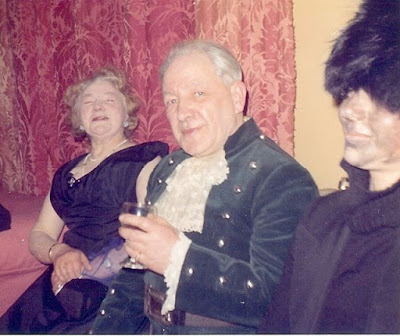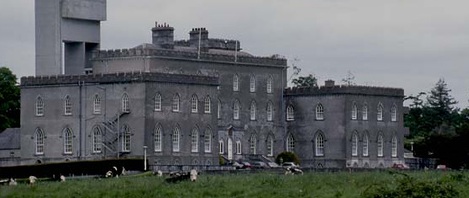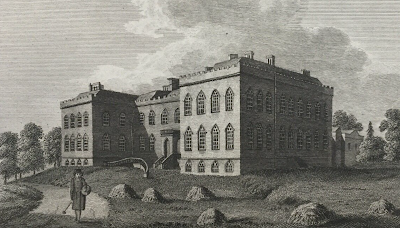THE MARQUESSES OF DROGHEDA WERE THE SECOND LARGEST LANDOWNERS IN COUNTY KILDARE, WITH 16,609 ACRES
This noble family came from France very early after the Conquest, and having acquired a good estate in Kent, resided at the manor of Moore Place, as early as the reign of HENRY II.
THOMAS MOORE, living in the reign of EDWARD II, was ancestor, after ten generations, of
JOHN MOORE, of Benenden Place, Kent, living, in 1519, married Margaret, daughter of John Brent, and had, among other issue,
Owen;
EDWARD (Sir), father of 1st Viscount Moore;
Nicholas.
Sir Edward and Sir Thomas went over to Ireland, as soldiers of fortune, in the reign of ELIZABETH I.
SIR EDWARD MOORE, the elder brother, obtained for his services, from Her Majesty, a lease of the dissolved abbey of
Mellifont, with its appurtenances, in County Louth, which he made the principal place of his abode; and it so continued that of his descendants until their removal to Moore Abbey, County Kildare, the seat of the
Viscounts Loftus, of Ely, which devolved upon the Earl of Drogheda.
He married Mildred, daughter and co-heir of Nicholas Clifford, of Great Chart, in Kent, and was succeeded at his decease by his eldest son,
SIR GARRET MOORE (1564-1627), Knight, of Mellifont, MP for Dungannon, 1613-15, who rendered distinguished assistance to the government of
ELIZABETH I, in quelling the Irish rebellion, and received at Mellifont the submission of Hugh O'Neill, Earl of Tyrone.
Sir Garret was elevated to the peerage in 1616, in the dignity of
Baron Moore; and advanced to a viscountcy, in 1621, as
Viscount Moore, of Drogheda.
His lordship wedded Mary, daughter of Sir Henry Colley, Knight, of Castle Carbery, County Kildare.
He was succeeded by his eldest surviving son,
CHARLES, 2nd Viscount (1603-43), who was killed at Portlester, County Meath, in the service of
CHARLES I; in which he had previously distinguished himself as a gallant and enterprising officer.
His lordship espoused Alice, younger daughter of Adam, 1st Viscount Loftus, and was succeeded by his eldest son,
HENRY, 3rd Viscount, who was created, in 1661, EARL OF DROGHEDA.
His lordship married Alice, fifth daughter of William, 2nd Baron Spencer, of Wormleighton, by Lady Penelope Wriothesley, daughter of Henry, Earl of Sunderland.
He died in 1676, was succeeded by his eldest son,
CHARLES, 2nd Earl, who wedded, in 1669, the Lady Letitia Isabella Robartes, daughter of John, Earl of Radnor, Lord Lieutenant of Ireland; but dying in 1679 without surviving issue, the honours devolved upon his brother,
HENRY, 3rd Earl, who had assumed the surname of
HAMILTON upon inheriting the estates of his brother-in-law, Henry, Earl of Clanbrassil.
His lordship espoused, in 1675, Mary, daughter of Sir John Cole Bt, of Newland, near Dublin, and sister of Arthur, Baron Ranelagh, and had issue,
CHARLES, father of 3rd & 4th Earls;
Arthur, dsp;
Henry, in holy orders;
John, in holy orders;
William;
Robert;
Capel;
Elizabeth.
The 3rd Earl died in 1714, and was succeeded by his grandson,
HENRY, 4th Earl (1700-27); who inherited the Loftus estates upon the decease of his maternal grandfather in 1725; but dying without an heir in 1727 (he had married Charlotte, daughter of Hugh, 1st Viscount Falmouth), those and the family honours and estates devolved upon his brother,
EDWARD, 5th Earl (1701-58), who wedded firstly, in 1727, the Lady Sarah Ponsonby, daughter of Brabazon, 1st Earl of Bessborough, and had issue,
CHARLES, his successor;
Ponsonby;
Edward, in holy orders.
His lordship married secondly, in 1747, Bridget, daughter of William Southwell, niece of Thomas, Lord Southwell, by whom he had two other sons,
William;
Robert.
The 5th Earl and his son, the Hon and Rev Edward Moore, were lost in their passage to Dublin in 1758.
He was succeeded by his eldest son,
CHARLES, 6th Earl (1730-1822), KP PC, who was created, in 1791, MARQUESS OF DROGHEDA.
His lordship wedded, in 1766, Lady Anne Seymour, daughter of Francis, 1st Marquess of Hertford, by whom he had issue,
CHARLES;
Henry Seymour;
Elizabeth Emily; Mary;
Gertrude; Frances.
His lordship was succeeded by his eldest son,
CHARLES, 2nd Marquess.
Earls of Drogheda (1661; Reverted)
The heir apparent is the present holder's son Benjamin Garrett Henderson Moore, styled Viscount Moore.
The 1st and 3rd Marquesses were Knights of St Patrick (KP).
The 11th Earl was a Knight of the Garter (KG).
The 10th Earl was the last Lord-Lieutenant of County Kildare, from 1918 until 1922.
MOORE ABBEY, near Monasterevin, County Kildare, was the large and luscious demesne of the Marquesses of Drogheda.
It was erected on the site of a medieval abbey.
The mansion was greatly repaired and improved about 1767; and is an extensive and commodious edifice, somewhat in the conventual style, yet quite destitute of all strongly marked architectural character.
The great hall is lined with Irish oak and is remarkable as the apartment in which the Court of Chancery was held by Adam, 1st Viscount Loftus, at the beginning of the 1641 rebellion.
The the site of the mansion is low, watery and without prospect, yet the surrounding demesne is very large and possesses some fine varieties of scenery; and the adjoining countryside ascends from the flat and boggy region on the north-east into a gentle and undulating mixture of low, pleasant and well-wooded hills.
The main front consists of a seven-bay central block of three storeys over a basement, with four-bay projecting wings of two storeys.
The windows all have pointed heads and Gothic astragals.
The roof parapets are battlemented.
There is an elaborate castellated entrance gateway to the demesne.
Following the dissolution of the monasteries, Moore Abbey passed to George, Lord
Audley, who assigned it to Adam, Viscount Loftus.
The site
was eventually acquired by the Moore family,
Earls of Drogheda.
They were responsible for building the town of Monasterevin and much of Dublin.
In
1767, the 6th Earl pulled down the old
abbey and used the stones to build a parish church, which
has now been replaced by St John's parish church.
He
replaced the abbey with a Neo-Gothic style mansion, now
Moore Abbey.
Preparations for a sunken garden,
in 1846, exposed a mass of skeletons on what was presumably the
site of the abbey cemetery.
In 1924, John McCormack, the world famous operatic tenor, leased the house from Lord Drogheda.
In
1938 the Sisters of Charity of Jesus
bought Moore Abbey where they now have a training school
for nurses of the mentally disabled.
Former town residence ~ Sackville Street, Dublin (now called O'Connell Street).
First published in August, 2011. Drogheda arms courtesy of European Heraldry.






























.jpg)

